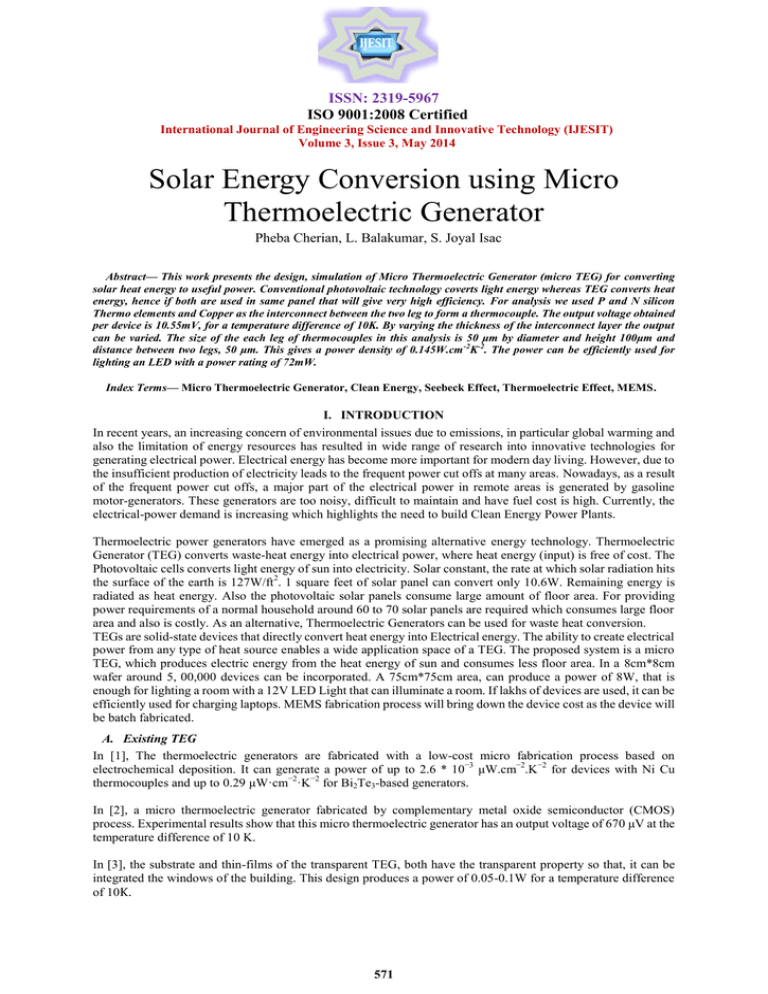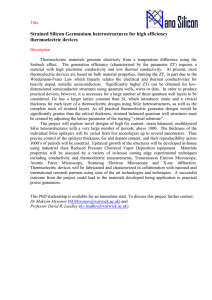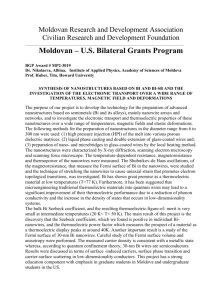Solar Energy Conversion using Micro Thermoelectric
advertisement

ISSN: 2319-5967 ISO 9001:2008 Certified International Journal of Engineering Science and Innovative Technology (IJESIT) Volume 3, Issue 3, May 2014 Solar Energy Conversion using Micro Thermoelectric Generator Pheba Cherian, L. Balakumar, S. Joyal Isac Abstract— This work presents the design, simulation of Micro Thermoelectric Generator (micro TEG) for converting solar heat energy to useful power. Conventional photovoltaic technology coverts light energy whereas TEG converts heat energy, hence if both are used in same panel that will give very high efficiency. For analysis we used P and N silicon Thermo elements and Copper as the interconnect between the two leg to form a thermocouple. The output voltage obtained per device is 10.55mV, for a temperature difference of 10K. By varying the thickness of the interconnect layer the output can be varied. The size of the each leg of thermocouples in this analysis is 50 μm by diameter and height 100μm and distance between two legs, 50 μm. This gives a power density of 0.145W.cm -2K-2. The power can be efficiently used for lighting an LED with a power rating of 72mW. Index Terms— Micro Thermoelectric Generator, Clean Energy, Seebeck Effect, Thermoelectric Effect, MEMS. I. INTRODUCTION In recent years, an increasing concern of environmental issues due to emissions, in particular global warming and also the limitation of energy resources has resulted in wide range of research into innovative technologies for generating electrical power. Electrical energy has become more important for modern day living. However, due to the insufficient production of electricity leads to the frequent power cut offs at many areas. Nowadays, as a result of the frequent power cut offs, a major part of the electrical power in remote areas is generated by gasoline motor-generators. These generators are too noisy, difficult to maintain and have fuel cost is high. Currently, the electrical-power demand is increasing which highlights the need to build Clean Energy Power Plants. Thermoelectric power generators have emerged as a promising alternative energy technology. Thermoelectric Generator (TEG) converts waste-heat energy into electrical power, where heat energy (input) is free of cost. The Photovoltaic cells converts light energy of sun into electricity. Solar constant, the rate at which solar radiation hits the surface of the earth is 127W/ft2. 1 square feet of solar panel can convert only 10.6W. Remaining energy is radiated as heat energy. Also the photovoltaic solar panels consume large amount of floor area. For providing power requirements of a normal household around 60 to 70 solar panels are required which consumes large floor area and also is costly. As an alternative, Thermoelectric Generators can be used for waste heat conversion. TEGs are solid-state devices that directly convert heat energy into Electrical energy. The ability to create electrical power from any type of heat source enables a wide application space of a TEG. The proposed system is a micro TEG, which produces electric energy from the heat energy of sun and consumes less floor area. In a 8cm*8cm wafer around 5, 00,000 devices can be incorporated. A 75cm*75cm area, can produce a power of 8W, that is enough for lighting a room with a 12V LED Light that can illuminate a room. If lakhs of devices are used, it can be efficiently used for charging laptops. MEMS fabrication process will bring down the device cost as the device will be batch fabricated. A. Existing TEG In [1], The thermoelectric generators are fabricated with a low-cost micro fabrication process based on electrochemical deposition. It can generate a power of up to 2.6 * 10−3 μW.cm−2.K−2 for devices with Ni Cu thermocouples and up to 0.29 μW·cm−2·K−2 for Bi2Te3-based generators. In [2], a micro thermoelectric generator fabricated by complementary metal oxide semiconductor (CMOS) process. Experimental results show that this micro thermoelectric generator has an output voltage of 670 μV at the temperature difference of 10 K. In [3], the substrate and thin-films of the transparent TEG, both have the transparent property so that, it can be integrated the windows of the building. This design produces a power of 0.05-0.1W for a temperature difference of 10K. 571 ISSN: 2319-5967 ISO 9001:2008 Certified International Journal of Engineering Science and Innovative Technology (IJESIT) Volume 3, Issue 3, May 2014 B. Objective of proposed work From the above studies, the existing thermoelectric generators are not optimal in design and the material used. The Bi2Te3 is not CMOS[4] compatible and not easily available, the glass substrate used is not suitable for exterior application and bridge type design offers more reliability and less contact resistance compared to the vertical and horizontal designs and also the air gap will provide high output. The proposed project aims at implementing a Micro Thermoelectric Generator that can convert solar energy. The design includes, Si Substrate and p and n type poly Si thermocouple elements arranged in a bridge like fashion, connected electrically in series and thermally in parallel. And interconnected to each other by a bridge of conductor (Cu).. II. DESIGN OF MICRO THERMOELECTRIC GENERATOR Factors which affect the design are: o Thermocouple(TC) layout o Leg length o Leg Cross Section(μm2) o Integration (TC’s /cm2) o Integration Density TC Layout [1] specifies the number of thermocouple’s per unit area. Leg length affects the amount of heat transferred from hot side to cold side. Leg cross section determines the area of contact. The output is same for circular, rectangular cross section of the TC legs, when area of cross section is same. Integration determines the number of thermocouples per unit area thereby defined the TC layout. Integration density is the ratio of inactive to Active Material. Active material is the thermocouple material and inactive material is the substrate. This varies with the Layout of the thermocouple. TABLE 1: Variation of Thermoelectric Potential with material and size Material of Thermolegs P and N Si P and N Si Size Top layer Potential Difference Temperature Difference (μm3 ) (Interconnect) (mV) (Th-Tc) K 50*50*100 150*230.9*153 Ni-Cr 50*50 *100 Al 10.4 10 Cu 10.55 10 Au 10.54 10 Al 10.6 10 Cu 10.7 10 Au 10.5 10 Cu 0.24 10 TABLE 2: Variation of Thermoelectric Efficiency Factor with layout and leg length TC Layout No: of TC’s TC Leg Length(µm) RG(Ω) Thermo Electric Efficiency Factor (µWcm-2K-2) A 99 75.4 0.224 1.72*10-4 B 86 153.1 0.225 2*10-3 572 ISSN: 2319-5967 ISO 9001:2008 Certified International Journal of Engineering Science and Innovative Technology (IJESIT) Volume 3, Issue 3, May 2014 90 C 253 D 69 E 84.1 0.235 5.78*10-4 157.5 0.162 1.04*10-3 81.8 0.252 2.16*10-4 101.5 0.727 8.03*10-4 81.1 0.671 6.22*10-4 142.1 0.201 2.63*10-3 87.9 0.194 6.84*10-4 The material properties which affect the output of the thermocouple are: Seebeck Coefficient, Thermal conductivity and Electrical Conductivity. Seebeck Coefficient S= -ΔV/ΔT ; (1) Where, ΔV- is the induced thermoelectric voltage. ΔT- Difference in temperature between the hot and cold junction. At a given temperature, electrical conductivity and thermal conductivity are proportional to each other. But as temperature increases, according to Wiedemann Franz law, κ /σ =LT ; (2) Where σ is the electrical conductivity, κ is the thermal conductivity, L is the Lorentz number The figure of merit Z for thermoelectric devices is defined as, Z = σ S2/ κ ; (3) TABLE 3: Variation of Thermoelectric Efficiency Factor with Design and Fabrication Techniques Properties Type1 Type2 Type3 Type4 TC Layout lateral Vertical Vertical Bridge Leg length(µm) 4500 3000 600 101-153 Material P-Si, N-Si Cu, Ni BiTeSb,Bi2Te3 P-Si, N-Si Seebeck Coefficient (μV/K) 530 20.6 200 530 Deposition Method Ion implanting Evaporation Sintering Surface Micromachining TE Efficiency factor -2 (µWcm K 0.0011 7.4*10-5 5 8.212*10-4 -2) III. THERMOELECTRIC EFFECT-PHYSICS The Thermoelectric Effect is known under three different names, Seebeck Effect, Peltier Effect and Thomson Effect. These three Effects are related thermodynamically by the equation: P=ST; (4) μ=T∙ d S/d T; (5) Where, P =Peltier Coefficient (V), S is the seebeck Coefficient (V/K), μ is the Thomson Coefficient (V/K),T is the temperature (K). Equations (4) and (5) shows that all these relations can be considered as one and the same effect. The flux quantities, Electric Flux and Heat Flux have to be considered while simulating Thermoelectric Effect. The heat Flux q can be given as, q= - κ ΔT + PJ; (6) 573 ISSN: 2319-5967 ISO 9001:2008 Certified International Journal of Engineering Science and Innovative Technology (IJESIT) Volume 3, Issue 3, May 2014 Current J, J= - σ ΔV- σ S ΔT ; (7) Also, Electric Field, E= - ΔV ; (8) Q=J∙E ; (9) Where, Q is the Joule heating According to Law of conservation of heat Energy and current ρ C∂T/∂t + Δ∙ q = Q ; (10) In stationary case, Δ∙q=Q; (11) Δ∙J=0; (12) Therefore, the equation becomes Δ ∙ (-σ ΔV- σ SΔT) = 0 ; (13) These Equations are included in the COMSOL Multiphysics. From [5], [6] and [7], the properties of thermoelectric Effect are included in the physics and a model is obtained with size of each leg = 50 μm diameter and 100 μm length. Distance between legs=50 μm The material used is P and N Type Si, and the Top Interconnect is Copper (5 μm thick). If the devices are arranged in the form of array, the output obtained can be efficiently used for power applications. Also it will take only minimum space IV. DESIGN USING COMSOL Fig 1: Single thermocouple structure-Temperature and Potential Distribution When area of Cross section(fig.1) is decreased by 35.036%, and leg length decreased by 34.6%, The Output Voltage decreases 0.66%.When the interconnect material is changed output voltage changes. For Au Interconnect (5 μm thick), Potential Difference: 10.54 mV, which is 0.189%> using Al. For Cu Interconnect (5 μm), Potential Difference: 10.55 mV, which is 0.284%> using Al. When Number of thermocouples are connected in series, the output voltage increases by 33% for each added thermocouple. If the thermocouples are connected in the form of bridge (fig 3)that will increase reliability and will give high output. 574 ISSN: 2319-5967 ISO 9001:2008 Certified International Journal of Engineering Science and Innovative Technology (IJESIT) Volume 3, Issue 3, May 2014 Fig 2: Variation of Potential with Temperature (a) (b) Fig 3: Thermocouples as array- Temperature distribution (a) and Potential distribution(b) V. CONCLUSION From the simulation results, we can conclude that P and N type Si when used as thermocouple material and interconnected using Copper will give a potential difference of 10.55mV for 10K Temperature difference. It gives a Power 0.116μW. For, lighting an LED of 12V 8W ~75*75cm2 needed This gives a power density of 0.145W.cm-2K-2.The power density obtained is 9000 times greater than that of Bi2Te3 based Micro Thermoelectric Generator[1]. REFERENCES [1] Wulf Glatz, Etienne Schwyter, Lukas Durrer, Bi2Te3-Based Flexible Micro Thermoelectric Generator With Optimized Design-Journal f Micro Electro Mechanical Systems- VOL. 18, NO. 3, JUNE 2009. [2] Pin-Hsu Kao, Po-Jen Shih, Ching-Liang Dai, Fabrication and Characterization of CMOS-MEMS Thermoelectric Micro Generators, Journal of sensors-2010, 101315-1325. [3] Guan-Ming Chen, I-Yu Huang, et.al. Development of a Novel Transparent Micro thermoelectric Generator for Solar Energy Conversion, IEEE International Conference -Feb, 2011, Taiwan. 575 ISSN: 2319-5967 ISO 9001:2008 Certified International Journal of Engineering Science and Innovative Technology (IJESIT) Volume 3, Issue 3, May 2014 [4] Jin Xie, Chengkuo Lee, and Hanhua Feng, Fabrication, and Characterization of CMOS-MEMS-Based Thermoelectric Power Generators IEEE-Journal of Micro Electro Mechanical Systems- VOL. 19, NO. 2, April 2010. [5] Multiphysics Analysis of Thermoelectric Phenomena, Excerpt Proceedings from COMSOL Conference, 2011. [6] A Flow Induced Vertical Thermoelectric Generator and Its Simulation Using COMSOL Multiphysics, Excerpt Proceedings From COMSOL Conference, 2011. [7] Multiphysics Simulation of Thermoelectric Systems - Modelling of Peltier-Cooling and Thermoelectric Generation, Excerpt Proceedings from COMSOL Conference, 2008. AUTHOR BIOGRAPHY Pheba Cherian received the B.Tech.degree in Electrical and Electronics Engineering from the Amal Jyothi College of Engineering, Kottayam, Kerala, India, in 2010 and completed M.Tech degree in Electronics and Control Engineering in SRM University, Chennai, India and currently working for the post of Assistant Professor at Electrical and Electronics Engineering Department in Saveetha Engineering College, Chennai, Tamil Nadu, Chennai L.Bala Kumar received the B.E.degree in Electrical and Electronics Engineering from the Sasurie College of Engineering, Tirupur, Tamil Nadu, India, in 2009 and completed M.Tech degree in Power Electronics and Drives in BS Abdur Rahman University, Chennai, India and currently working for the post of Assistant Professor at Electrical and Electronics Engineering department in Saveetha Engineering College, Chennai, Tamil Nadu, Chennai S,Joyal Isac received the B.E.degree in Electrical and Electronics Engineering from the Sree Sowdambika Engineering College, Arupukottai, Tamil Nadu, India, in 2009 and completed M.E degree in Power Systems Engineering, Velammal Engineering College, Chennai, India and currently working for the post of Assistant Professor at Electrical and Electronics Engineering Department in Saveetha Engineering College, Chennai, Tamil Nadu, Chennai. 576


